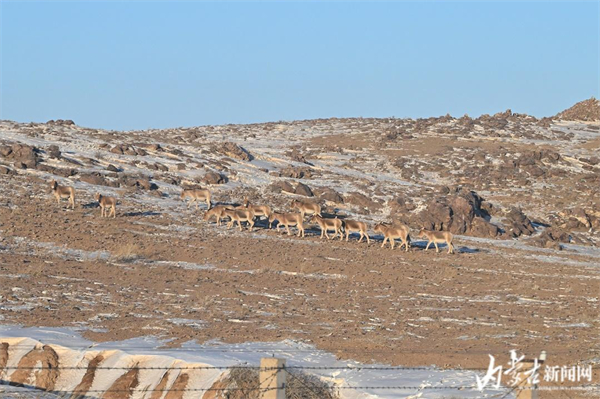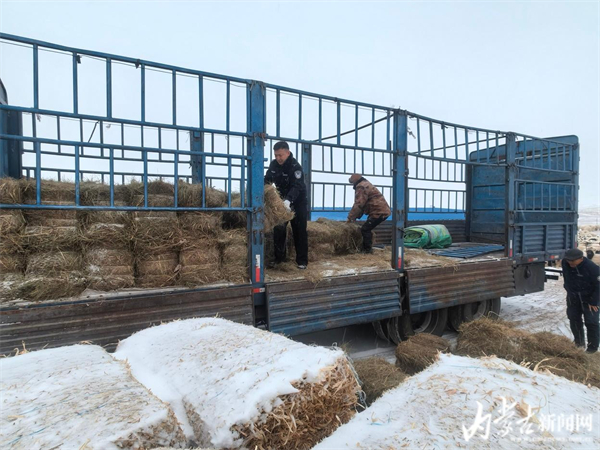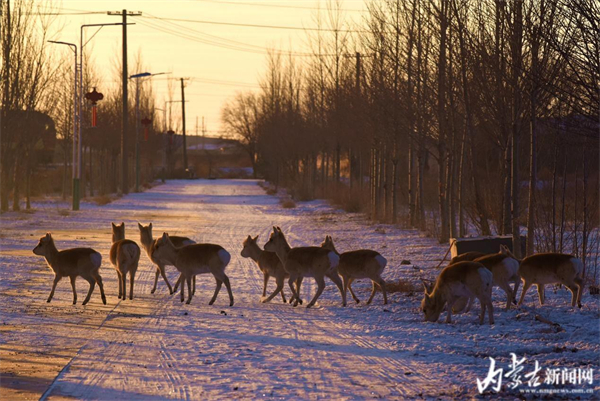Ereenhot safeguards migrated wild animals on border

Mongolian gazelles migrate along the border between China and Mongolia. [Photo/Inner Mongolia News Network]
As winter ended, thousands of rare wild animals, including Mongolian gazelles and Mongolian wild donkeys, migrate in groups along the border between China and Mongolia, heading for Ereenhot city in North China's Inner Mongolia autonomous region.
Their arrival not only showcases nature's wonder, but also presents a crucial test for cross-border wildlife protection systems.
In response to the increasing number of cross-border wild animals, Ereenhot has implemented a series of measures for animal protection.
Since last year, the city's departments of land and public security, along with organizations and local residents, have formed a new collaborative "government + volunteers" model to ensure wildlife safety.
Relevant departments in the city have also intensified patrols of wildlife habitats, promptly and effectively conducting wildlife rescue operations to reduce abnormal wildlife deaths.
Meanwhile, they are also conducting various forms of wildlife protection seminars and training to improve the survival rate of rescued animals.
Based on the habitat and migration routes of wild animals, the Ereenhot bureau of natural resources has selected three locations as well as the pastures of six herding families, as wild animal rescue points. Volunteers have been hired to carry out rescue work promptly.

Donated hay for migrated wild animals along the China-Mongolia border is unloaded from a truck. [Photo/Inner Mongolia News Network]
In 2023, the Ereenhot bureau of natural resources rescued 562 Mongolian gazelles and six wild Mongolian donkeys, both of which are national first-class protected animals.
Since winter began, the Ereenhot public security bureau has organized police officers to continuously conduct patrols to protect the local wildlife. These patrols will focus on monitoring the illegal hunting of migrating gazelles and donkeys.
The Ereenhot public security bureau has also cooperated with other departments to carry out special operations and intensify penalties for unauthorized operations, such as the illegal purchase and trade of wildlife products, thus cracking down on wildlife trade activities.
Looking ahead, the Ereenhot bureau of natural resources is applying for the establishment of a China-Mongolia cross-border wildlife migration corridor and the construction of a corridor for desertification control along the border. These will provide fundamental support for wildlife protection in Ereenhot.
Having worked and lived in Ereenhot for more than 20 years, Zhang Peng considers this city his second home, and has always been enthusiastic about public welfare activities.
On Jan 22, Zhang spearheaded the establishment of the Ereenhot Wildlife Conservation Association. The association has already recruited more than 50 volunteers.
Today, the association's volunteers patrol the China-Europe railway lines, industrial parks, and suburban green belts that are frequented by Mongolian gazelles and donkeys. These volunteers promptly bring injured or stranded wild animals back to the rescue points upon receiving hotline calls from citizens. Such patrols have been conducted hundreds of times.
Every day, Zhang Peng and the volunteers feed and provide water to the animals at the rescue points. They then release these animals back into the wild once they have recovered.

Migrating Mongolian gazelles walk across a road in Ereenhot city. [Photo/Inner Mongolia News Network]



 Print
Print Mail
Mail


